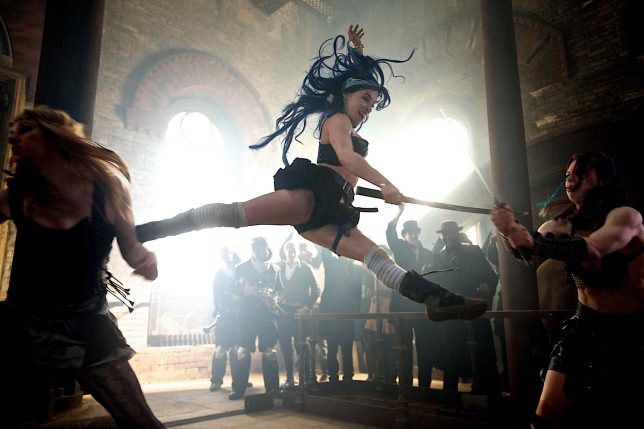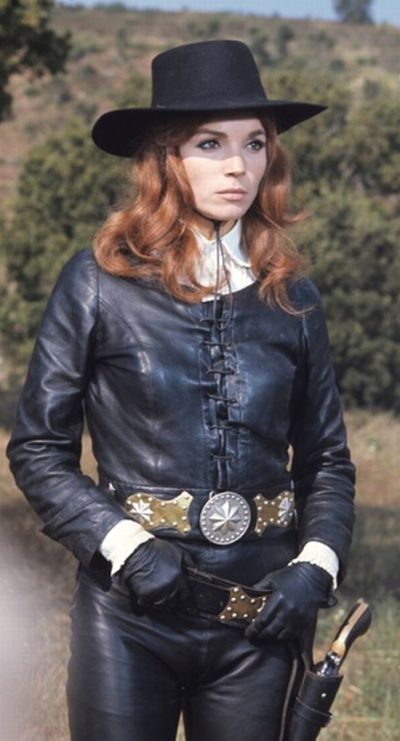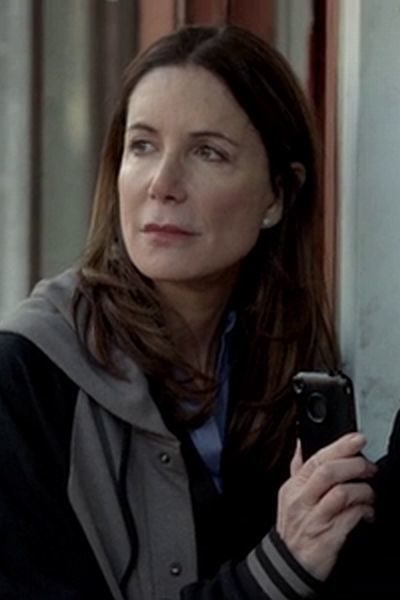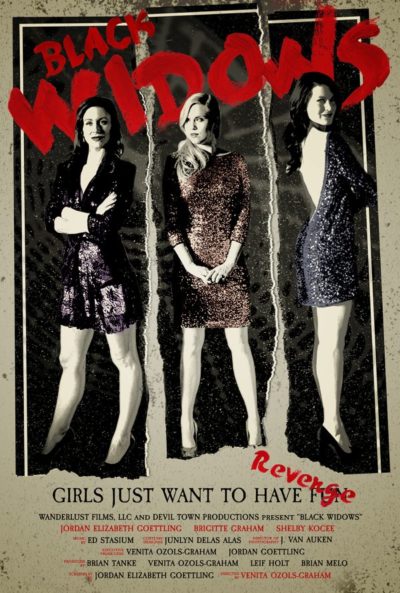★★★
“Not QUITE what the cover would suggest…”
 I’m unsure who the woman is on the DVD sleeve. I can only presume it’s Lady Not-Appearing-In-This-Film. For what we have instead seems to be a real labour of love for British stunt-woman Cecily Fay. Though calling her a mere stunt-woman would be selling her short: she also wrote, directed, starred in, edited and scored this feature, plus did the fight choreography and sound re-recording, while sewing every sequin on the costumes herself. Okay, the last might be a bit of a stretch, but since she is also credited as the costume designer… perhaps not. Hell, even Robert Rodriguez doesn’t have such a large collection of hats, and this overwhelming multi-tasking might help explain why it took close to five years between the start of filming and its eventual release. The main problem is that Fay’s talents, while considerable, are not equally spread.
I’m unsure who the woman is on the DVD sleeve. I can only presume it’s Lady Not-Appearing-In-This-Film. For what we have instead seems to be a real labour of love for British stunt-woman Cecily Fay. Though calling her a mere stunt-woman would be selling her short: she also wrote, directed, starred in, edited and scored this feature, plus did the fight choreography and sound re-recording, while sewing every sequin on the costumes herself. Okay, the last might be a bit of a stretch, but since she is also credited as the costume designer… perhaps not. Hell, even Robert Rodriguez doesn’t have such a large collection of hats, and this overwhelming multi-tasking might help explain why it took close to five years between the start of filming and its eventual release. The main problem is that Fay’s talents, while considerable, are not equally spread.
The issues are particularly apparent in the writing and editing departments. The first is kinda forgivable, and hardly a rarity in low-budget cinema, But I still find myself always hoping for something better – in this case, than an ill-considered mash-up of Star Wars and Gladiator. Azura (Fay) is the last survivor of her planet, Sarnia. She has been captured by Section Commander Sorrentine (Simpson), the ruthless dictator responsible for wiping out Azura’s people, and is made to fight for the amusement of the masses. While Azura plots her vengeance, a small rebellion (very small – like, it has four people in it, tops…) is brewing under the leadership of Viridian (Burniston), and is preparing a devastating strike against the Empire.
The whole SF angle is just not very well thought-out. These people have interplanetary travel, yet haven’t made a gun that takes less than five seconds to reload? I know every non-historical martial arts film has to handle it somehow, but this is close to the feeblest excuse I’ve heard. Given how little the future has to do with the rest of the plot, Fay would have been better off abandoning it entirely, making Sarnia an island instead of a planet, and setting it in the past to wipe out the firearm issue entirely. But worse, still, is the editing. You’d think Fay would know how to assemble an action sequence. Apparently not, for the movie adopts the Moulinex approach of choppy editing, which makes it so much harder to appreciate the skills of the fighters. There is one scene – here’s a GIF taken from it, to give you some idea – which is awesome (even if rather cribbed from Kill Bill), simply because Fay the director steps back and lets Fay the stunt-woman do her thing. It’s just a shame the rest wasn’t shot similarly.
 More positively, we have Fay’s acting and directorial talents. The former isn’t much of a surprise, as I enjoyed her performance in Warrioress, and she brings the same sense of conviction to proceedings as the heroine here. You may not believe any number of things about this world, but you can always believe Fay could be the last survivor of her species. The rest of the performances are.. a bit of a mixed bag, shall we say. Some appear to have strayed in from a fashion show at a steampunk convention, but punk veteran John Robb is clearly enjoying himself enormously as the arena MC [I got a vaguely Michael Rooker vibe off him!]
More positively, we have Fay’s acting and directorial talents. The former isn’t much of a surprise, as I enjoyed her performance in Warrioress, and she brings the same sense of conviction to proceedings as the heroine here. You may not believe any number of things about this world, but you can always believe Fay could be the last survivor of her species. The rest of the performances are.. a bit of a mixed bag, shall we say. Some appear to have strayed in from a fashion show at a steampunk convention, but punk veteran John Robb is clearly enjoying himself enormously as the arena MC [I got a vaguely Michael Rooker vibe off him!]
Given this was also Fay’s directorial debut, it’s acceptably solid. She avoids the obvious pitfalls, and if more functional than stylish, she has clearly been a) around enough TV/film sets, and b) paying attention on them, to handle things. I’ve seen far worse efforts from people with far longer IMDb resumes to their names. However, the bottom line is that you will still need a solid tolerance for low-budget cinema, and all that entails, for this to be acceptable viewing, though accepting its status as an obvious passion project will help mitigate the flaws. And this may be unprecedented, but I almost wish they’d gone for a less gratuitous title and sleeve; they both suggest something I should probably save for when Chris is out of the house, when the reality is considerably more restrained.
Dir: Cecily Fay
Star: Cecily Fay, Michael Collin, Joelle Simpson, Cheryl Burniston





 ★★★½
★★★½
 This is virtually unique, in being almost the only spaghetti Western with a female lead, and certainly unique in being the only one
This is virtually unique, in being almost the only spaghetti Western with a female lead, and certainly unique in being the only one  Ann Willis (Robbins) is a single mother, working as a waitress and trying to keep family together after the death of her husband from lung cancer. To help out, son David (Abrahamson) abandons his plans to attend college and gets a job in a local factory. But he falls in with some questionable company there and, lured by the prospect of easy money, starts dealing drugs for the local mobsters, run by Canarsie. Things go from bad to worse after his supposed “friend” Mike (Falahee) frames him for the disappearance of some product, and things end with David’s dead body floating in the river, having been beaten to death by his associates. The cops, and in particular, Detective Frank Hogan (Baldwin), investigate – but to be honest, aren’t particularly interested in one drug-dealer being killed.
Ann Willis (Robbins) is a single mother, working as a waitress and trying to keep family together after the death of her husband from lung cancer. To help out, son David (Abrahamson) abandons his plans to attend college and gets a job in a local factory. But he falls in with some questionable company there and, lured by the prospect of easy money, starts dealing drugs for the local mobsters, run by Canarsie. Things go from bad to worse after his supposed “friend” Mike (Falahee) frames him for the disappearance of some product, and things end with David’s dead body floating in the river, having been beaten to death by his associates. The cops, and in particular, Detective Frank Hogan (Baldwin), investigate – but to be honest, aren’t particularly interested in one drug-dealer being killed. Stumbled across this low-budget horror flick almost by accident when I was Googling the similarly-titled but very different,
Stumbled across this low-budget horror flick almost by accident when I was Googling the similarly-titled but very different,  Yoga instructor May (Biel) is delighted when she finally tracks down her long-lost biological sister, Shiva (Mamet) whom she has never met. However, the reunion is soured because May discovers the abusive relationship in which Shiva is embroiled. Worse is to come, as she finds out that Shiva is actually a hooker, and her significant other, Cody (Anderson), is more pimp than boyfriend. May’s efforts to help her sibling run into stormy water – not just from Cody, but also her own boyfriend, Dex (Gathegi) and adopted mother, who think Shiva and Cody are just shaking May down. Eventually, the point comes where May has to come out of this middle-class comfort-zone, because the downward dog position isn’t going to help her and Shiva escape their increasingly perilous situation.
Yoga instructor May (Biel) is delighted when she finally tracks down her long-lost biological sister, Shiva (Mamet) whom she has never met. However, the reunion is soured because May discovers the abusive relationship in which Shiva is embroiled. Worse is to come, as she finds out that Shiva is actually a hooker, and her significant other, Cody (Anderson), is more pimp than boyfriend. May’s efforts to help her sibling run into stormy water – not just from Cody, but also her own boyfriend, Dex (Gathegi) and adopted mother, who think Shiva and Cody are just shaking May down. Eventually, the point comes where May has to come out of this middle-class comfort-zone, because the downward dog position isn’t going to help her and Shiva escape their increasingly perilous situation. Three women friends – Darcy (Elizabeth), Nora (Graham) and Olivia (Kocee) – are all having shitty luck with their relationships. Olivia is in the middle of an ugly divorce from Adam. Nora’s boyfriend Ryan is a control freak. And while Darcy’s new friend Blair (Brown) initially seems fine, he turns out to be the worst of them all. After he refuses to take no for an answer, the trio decide revenge is a dish best served naked in the middle of the desert. Unfortunately for him, Blair ends up lacking a pulse. Unfortunately for the film, it takes forever to get to this point, and for the vast majority of its running-time the promised “dark comedy” is neither dark nor comedic.
Three women friends – Darcy (Elizabeth), Nora (Graham) and Olivia (Kocee) – are all having shitty luck with their relationships. Olivia is in the middle of an ugly divorce from Adam. Nora’s boyfriend Ryan is a control freak. And while Darcy’s new friend Blair (Brown) initially seems fine, he turns out to be the worst of them all. After he refuses to take no for an answer, the trio decide revenge is a dish best served naked in the middle of the desert. Unfortunately for him, Blair ends up lacking a pulse. Unfortunately for the film, it takes forever to get to this point, and for the vast majority of its running-time the promised “dark comedy” is neither dark nor comedic. It kinda works, mostly for the dynamics between the trio of leading ladies. At first, Cali’s approach seems sensible, arguably a legitimate way to make the best of a bad situation. However, a change in the scenario shifts things seismically, and even the toughest of her supporters would have to admit an unpleasant streak of psychopathy is opened in her make-up. Evil sometimes wears a pretty face, and Turshen reminded me more than a little of Denise Richards in Wild Things – manipulative and . Less successful, to the point of entire irrelevance, is the boyfriend who shows up and yells for a bit. I suspect, given the slight running time of 75 minutes, his presence may have been a late-added necessity in order to reach feature length.
It kinda works, mostly for the dynamics between the trio of leading ladies. At first, Cali’s approach seems sensible, arguably a legitimate way to make the best of a bad situation. However, a change in the scenario shifts things seismically, and even the toughest of her supporters would have to admit an unpleasant streak of psychopathy is opened in her make-up. Evil sometimes wears a pretty face, and Turshen reminded me more than a little of Denise Richards in Wild Things – manipulative and . Less successful, to the point of entire irrelevance, is the boyfriend who shows up and yells for a bit. I suspect, given the slight running time of 75 minutes, his presence may have been a late-added necessity in order to reach feature length.
 Normally, I like to start a series at the beginning. But I chose to read this second novella of Brackett’s Eric John Stark series, as my long-awaited first introduction to her work, because Amazon offered me the chance to read it for free on my Kindle app. (And yes, I’ll definitely be buying a paper copy!) That means there are unanswered questions here about Stark’s origins and background, and about the Martian world –what kind of “beasts” are used as mounts here, for instance, or what the economic base of a city-state like Kushat is– that probably have answers in the first book, or earlier stories. (The author wrote about the character in both formats, and not all of the corpus is still in print.)
Normally, I like to start a series at the beginning. But I chose to read this second novella of Brackett’s Eric John Stark series, as my long-awaited first introduction to her work, because Amazon offered me the chance to read it for free on my Kindle app. (And yes, I’ll definitely be buying a paper copy!) That means there are unanswered questions here about Stark’s origins and background, and about the Martian world –what kind of “beasts” are used as mounts here, for instance, or what the economic base of a city-state like Kushat is– that probably have answers in the first book, or earlier stories. (The author wrote about the character in both formats, and not all of the corpus is still in print.)